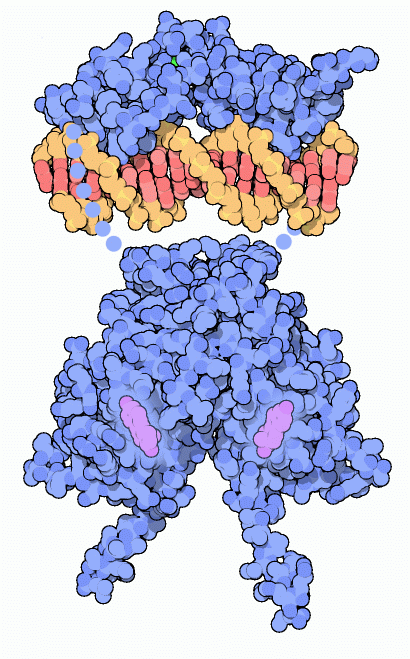|
Inhaltsübersicht | Nanomaschinen | Moleküle | Programme | Kurse | Fun | Links |
||
| > |
Estrogen Receptor

Our bodies grow in two major spurts during our lives. You probably don't remember the first, which occurred during the first few months of your life as you grew from a single cell into a fully formed baby. On the other hand, you probably have many memories (or you may be making those memories now) of your second frenzy of growth. During puberty, sex hormones direct selected tissues to undergo a second wave of growth and development. In women, estrogen hormones are largely responsible for coordinating these changes. Estrogens are made in the ovaries and then delivered within seconds throughout the body in the blood, directing the growth from child to adult.
Straight to the Source
Estrogens are small, carbon-rich molecules built from cholesterol. This is quite different than larger hormones, such as insulin and growth hormone, which are sensed by receptors on the cell surface. Estrogens pass directly into cells throughout the body, so the cell can use receptors that are in the nucleus, right at the site of action on the DNA. When estrogen enters the nucleus, it binds to the estrogen receptor, causing it to pair up and form a dimer. This dimer then binds to several dozen specific sites in the DNA, strategically placed next to the genes that need to be activated. Then, the DNA-bound receptor activates the DNA-reading machinery and starts the production of messenger RNA.A Large Family
When researchers looked into the human genome, they found over 150 proteins that are similar to the estrogen receptor. This is a large family of nuclear receptors that sense the levels of small hormones and other signaling molecules, such as steroid and thyroid hormones, vitamin D, and retinoic acid. Like estrogen, these are all small molecules that pass directly into cells and find their way to the nucleus. These receptors each bind to a specific signaling molecule and then activate or repress their own set of 50-100 genes. For more information on nuclear receptors from a genomic perspective, take a look at the Protein of the Month feature at the European Bioinformatics Institute.Recognizing Estrogens
The estrogen receptor, and other nuclear receptors, are composed of several parts connected into one long chain. The structures of two of these parts are available in the PDB. At one end is the part that binds to the hormone, shown at the bottom of the illustration from PDB entry 1a52. This structure has estradiol bound, shown here in purple. This is connected to a DNA-binding domain that recognizes specific sequences of DNA, shown here at the top using coordinates in PDB entry 1hcq. Finally, there is a large transactivation domain attached at the end of the DNA-binding domain, which is not shown here. It activates RNA polymerase when the receptor binds to DNA.Next: Estrogen and Cancer
Last changed by: A.Honegger,